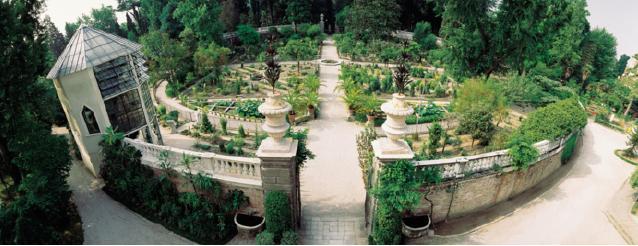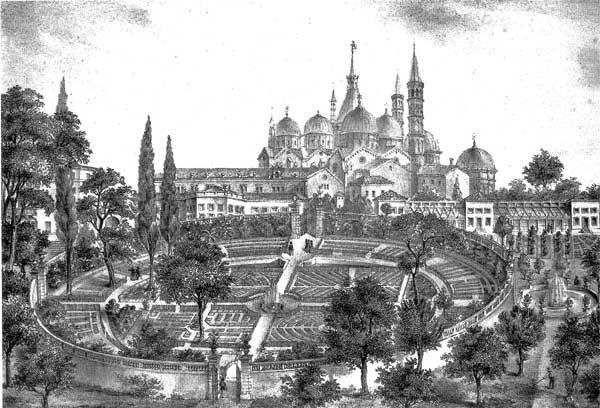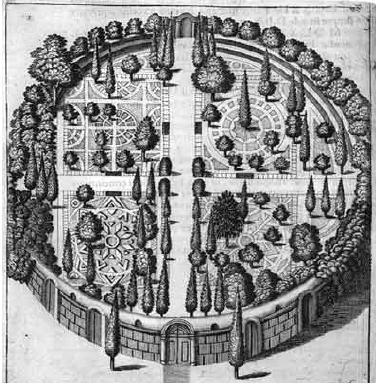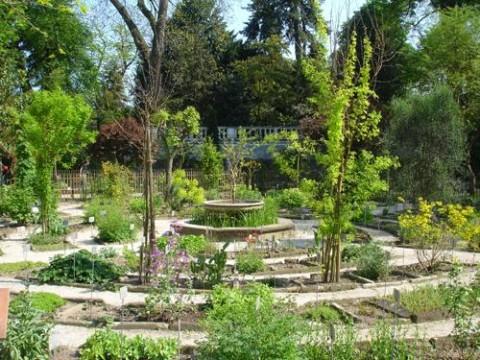|

 Founded in 1545, the Botanical Garden (Orto Botanico) of Padua is the oldest University Botanical Garden (Horto Medicinale) of the world that has kept its original site, and its structure practically unaltered. It was established by the Republic of Venice upon demand of the medical school of the University of Padua, for the cultivation of medicinal plants, which at that time constituted the majority of the "simple" plants, that is, those medicines that came directly from nature. For this reason the first botanical gardens were called Gardens of Simples (Hortus Simplicium). There reigned during those times a great uncertainty about the identification of the plants used as therapy by the celebrated doctors of antiquity, and errors and frauds were frequent, causing grave damage to the public health. The creation of the botanical garden would help the students of the University of Padua to recognize the true medicinal herbs from adulterations. The fist keeper of the Botanical Garden was Luigi Squalermo, also known as Anguillara who had a great number of plants planted (nearly 1800). Founded in 1545, the Botanical Garden (Orto Botanico) of Padua is the oldest University Botanical Garden (Horto Medicinale) of the world that has kept its original site, and its structure practically unaltered. It was established by the Republic of Venice upon demand of the medical school of the University of Padua, for the cultivation of medicinal plants, which at that time constituted the majority of the "simple" plants, that is, those medicines that came directly from nature. For this reason the first botanical gardens were called Gardens of Simples (Hortus Simplicium). There reigned during those times a great uncertainty about the identification of the plants used as therapy by the celebrated doctors of antiquity, and errors and frauds were frequent, causing grave damage to the public health. The creation of the botanical garden would help the students of the University of Padua to recognize the true medicinal herbs from adulterations. The fist keeper of the Botanical Garden was Luigi Squalermo, also known as Anguillara who had a great number of plants planted (nearly 1800).
Because of continuous night thefts, a circular wall was built to enclose it. The Garden was conti nuously enriched with plants from various parts of the world, and especially from countries where the Republic of Venice had estates on, or with which it traded. Because of this Padua has played a prominent role in the introduction and in the study of many exotic plants. The Garden has witnessed the evolution of Botany as a science applied to medicine to the various branches that make it up now. nuously enriched with plants from various parts of the world, and especially from countries where the Republic of Venice had estates on, or with which it traded. Because of this Padua has played a prominent role in the introduction and in the study of many exotic plants. The Garden has witnessed the evolution of Botany as a science applied to medicine to the various branches that make it up now.
The library, the herbarium and various laboratories were created annexed to the Garden, sometimes at the price of sacrificing the greenhouses. Today it covers a total area of approximately three and a half hectares, and is in the phase of enlargement. Like similar university institutions, in Italy and abroad, the Padua Botanical Garden carries on didactic as well as popular work, with various research projects, including the conservation of rare and endangered species of plants. In 1997, the Botanical Garden was declared a world humanity heritage institution by UNESCO.
In July, 2002, it became an autonomous university centre; it is directed by a prefect and managed by a technical-scientific committee. A concept of Daniele Barbaro, a Venetian aristocrat, ambassador of the Serenissima Republic and a man of great culture, the project of the Garden was entrusted to the greatest architect working in Padua at the middle of the 1500s, Andrea Moroni, of Bergamo, responsible also for the 15th-century reconstructions of the Basilica of S. Giustina, of the Town Hall and the University. The Garden, in fact, was not supposed to be just a place for the cultivation, acclimatization and exhibition of plants, but also a "monument". Its strong architectural mark consisted in the perfection of the circle with a square, inscribed in it, and divided in four parts by two paths oriented towards the cardinal points. In each quarter, the "plots" for the cultivation of diverse species were arranged in different elegant geometric designs. At the end of the 1500s fountains were added, fed by a gigantic wheeled water-supply system also used for irrigation.
 The main palace was realized between the 1600s and the 1700s, while the four entrance portals, with splendid red ammonite acroters dominated with wrought-iron vegetation, go back to 1704. In the first half of the 18th century a balustrade in Istrian stone was added along the external perimeter, on which vases and busts of distinguished individuals were displayed. Later, the statues of Theophrastus (near the southern doorway) and of Solomon (eastern doorway), the fountain of the four seasons with four 18th century busts in Carrara marble were accomplished. The main palace was realized between the 1600s and the 1700s, while the four entrance portals, with splendid red ammonite acroters dominated with wrought-iron vegetation, go back to 1704. In the first half of the 18th century a balustrade in Istrian stone was added along the external perimeter, on which vases and busts of distinguished individuals were displayed. Later, the statues of Theophrastus (near the southern doorway) and of Solomon (eastern doorway), the fountain of the four seasons with four 18th century busts in Carrara marble were accomplished.
The Garden keeps three sundials: a cube, a sphere and a cylinder. Outside the circular wall are the Arboretum, some plant collections considered important for environment-friendly considerations, a collection of plants introduced in Italy for the first time (and some even in Europe) by the Botanical Garden of Padua, the greenhouses (of oranges, orchids, and ferns), a "botanical theatre" realized in the 19th century to deliver lectures. In the Garden around 6,000 plants are cultivated, and exchanges are in place with over 800 botanical gardens in the five continents by means of the "seminum index".
The most antique living plant is a Palm of St. Peter (Chamaerops humilis var. arborescens) planted in 1585. It is called "Goethe Palm" after the famed German poet who in 1786, after having studied it, expressed his evolution intuition in his 1790s essay on "The Metamorphosis of Plants". There are also species of plants under extinction in the Garden, being studied for ways to ensure their survival. Of great interest are the sections on medicinal, poisonous and insect-eating plants, as they are among the most complete in Europe.
Historical herbal books, scientific texts, and precious illustrated books in water colours or tempera, many of which are unique copies, are stored in the annexed Library.
|


 Founded in 1545, the Botanical Garden (Orto Botanico) of Padua is the oldest University Botanical Garden (Horto Medicinale) of the world that has kept its original site, and its structure practically unaltered. It was established by the Republic of Venice upon demand of the medical school of the University of Padua, for the cultivation of medicinal plants, which at that time constituted the majority of the "simple" plants, that is, those medicines that came directly from nature. For this reason the first botanical gardens were called Gardens of Simples (Hortus Simplicium). There reigned during those times a great uncertainty about the identification of the plants used as therapy by the celebrated doctors of antiquity, and errors and frauds were frequent, causing grave damage to the public health. The creation of the botanical garden would help the students of the University of Padua to recognize the true medicinal herbs from adulterations. The fist keeper of the Botanical Garden was Luigi Squalermo, also known as Anguillara who had a great number of plants planted (nearly 1800).
Founded in 1545, the Botanical Garden (Orto Botanico) of Padua is the oldest University Botanical Garden (Horto Medicinale) of the world that has kept its original site, and its structure practically unaltered. It was established by the Republic of Venice upon demand of the medical school of the University of Padua, for the cultivation of medicinal plants, which at that time constituted the majority of the "simple" plants, that is, those medicines that came directly from nature. For this reason the first botanical gardens were called Gardens of Simples (Hortus Simplicium). There reigned during those times a great uncertainty about the identification of the plants used as therapy by the celebrated doctors of antiquity, and errors and frauds were frequent, causing grave damage to the public health. The creation of the botanical garden would help the students of the University of Padua to recognize the true medicinal herbs from adulterations. The fist keeper of the Botanical Garden was Luigi Squalermo, also known as Anguillara who had a great number of plants planted (nearly 1800). nuously enriched with plants from various parts of the world, and especially from countries where the Republic of Venice had estates on, or with which it traded. Because of this Padua has played a prominent role in the introduction and in the study of many exotic plants. The Garden has witnessed the evolution of Botany as a science applied to medicine to the various branches that make it up now.
nuously enriched with plants from various parts of the world, and especially from countries where the Republic of Venice had estates on, or with which it traded. Because of this Padua has played a prominent role in the introduction and in the study of many exotic plants. The Garden has witnessed the evolution of Botany as a science applied to medicine to the various branches that make it up now. The main palace was realized between the 1600s and the 1700s, while the four entrance portals, with splendid red ammonite acroters dominated with wrought-iron vegetation, go back to 1704. In the first half of the 18th century a balustrade in Istrian stone was added along the external perimeter, on which vases and busts of distinguished individuals were displayed. Later, the statues of Theophrastus (near the southern doorway) and of Solomon (eastern doorway), the fountain of the four seasons with four 18th century busts in Carrara marble were accomplished.
The main palace was realized between the 1600s and the 1700s, while the four entrance portals, with splendid red ammonite acroters dominated with wrought-iron vegetation, go back to 1704. In the first half of the 18th century a balustrade in Istrian stone was added along the external perimeter, on which vases and busts of distinguished individuals were displayed. Later, the statues of Theophrastus (near the southern doorway) and of Solomon (eastern doorway), the fountain of the four seasons with four 18th century busts in Carrara marble were accomplished.